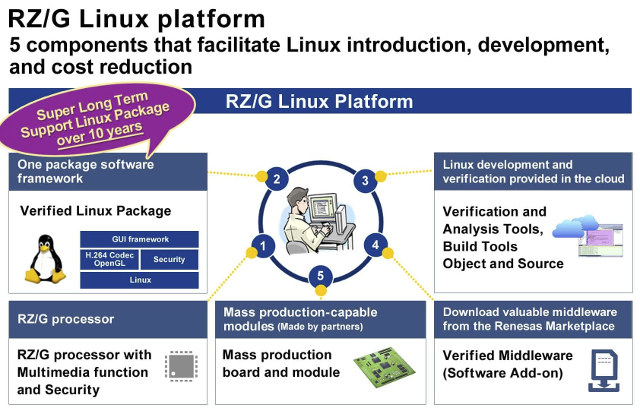In the consumer space, some devices never get updated, and you can consider yourself lucky if the manufacturer provides updates for several years, often just two as Linux LTS (Long Term Support) kernels had been supported that long so far. Google and the Linux Foundation realized that was not enough, so they recently announced 6-year LTS kernels at Linaro Connect SFO 2017, starting with Linux 4.4 released on January 2016, meaning it will keeping being maintained until January 2022 with security patchsets and bug fixes.
But in the industrial/embedded space, they need even longer periods of support due to the longer equipment’s lifespan. I first heard about the Linux Foundation’s Civil Infrastructure Platform (CIP) project last year, when I covered the schedule for the Embedded Linux Conference Europe 2016. The project aims at providing a super long-term supported (STLS) open source “base layer” for industrial grade software.
Several companies are partners of the project including Hitachi, Renesas, Siemens, Toshiba, and others, and Renesas appears to be the first to announce a product – Renesas RZ/G Linux Platform – featuring the industrial-grade CIP Super Long-Term Support (SLTS) Linux kernel enabling Linux-based embedded systems to be maintained for more than 10 years.
 Key features of the RZ/G Linux Platform:
Key features of the RZ/G Linux Platform:
- Verified Linux package – Supports the CIP SLTS kernel with BSP, multimedia functionality (H.264, 3D graphics), Qt/HTML5 GUI framework, and security.
- Development tools – Cloud development environment within Renesas’ e² studio integrated software development tool, code validation and analysis tools
- Third-party ecosystem and marketplace – The Renesas Marketplace provides access to software and hardware solutions, and users can buy and download security tools, embedded vision libraries, and other software.
- Support for RZ/G1M MPU now, with other Renesas RZ/G1 MPU series coming later.
You can find more details about the RZ/G Linux platform, and supported hardware on the product page. The RZ/G Linux Platform will also be demonstrated at upcoming event including Arm TechCon, (US – October 24-26, 2017), the Embedded Linux Conference Europe (Czech Republic – October 23-25, 2017), SPS IPC Drives (Germany, November 28-30), and CIIF 2017 (China, November 7-11, 2017).
Via ElectronicsWeekly and LinuxGizmos.

Jean-Luc started CNX Software in 2010 as a part-time endeavor, before quitting his job as a software engineering manager, and starting to write daily news, and reviews full time later in 2011.
Support CNX Software! Donate via cryptocurrencies, become a Patron on Patreon, or purchase goods on Amazon or Aliexpress




